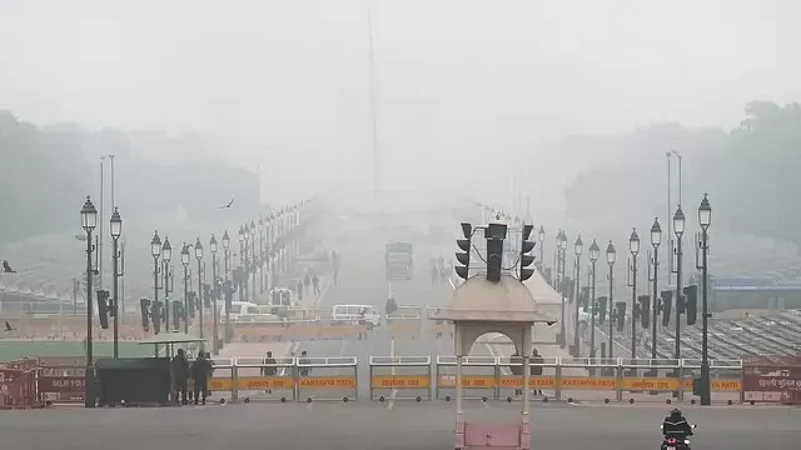Widespread fog impaired road and rail transportation in the northern and eastern regions of the country on Thursday. Wednesday marked the coldest day of the season in Jammu, as the maximum temperature dropped nine notches below normal, settling at 9 degrees Celsius.
Delhi experienced cold day conditions as the maximum temperature settled at 15.2 degrees Celsius on Wednesday, which is four notches below the normal range.
IMD on fog affecting cities across the nation
The India Meteorological Department (IMD) reported “very dense” fog in isolated pockets of Punjab, west Uttar Pradesh, and Tripura; “dense” fog in parts of east Uttar Pradesh; Jammu, Haryana, Delhi, east Madhya Pradesh, Bihar, and Assam; and “moderate” fog in some pockets of north Rajasthan and west Madhya Pradesh.
Visibility levels dropped to zero metres in Punjab’s Bhatinda and Agra in Uttar Pradesh, 25 metres in Tripura’s Agartala, and 50 metres in Jammu, Hisar in Haryana, Varanasi, and Lucknow in Uttar Pradesh, Sagar and Satna in Madhya Pradesh, Purnea in Bihar, and Assam’s Tezpur. Rajasthan’s Ganganagar and Bhopal in west Madhya Pradesh recorded a visibility level of 200 metres.
Parts of the northern plains recorded a lower maximum temperature compared to the hills on January 9 and 10.
Weather in Delhi
Dense fog conditions have caused delays for 24 trains bound for Delhi from different regions of the country.
The Palam Observatory, near the Indira Gandhi International Airport, reported a visibility level of 100 metres at 5:30 am. However, it improved to 500 metres by 7 am due to surface winds.
Delhi recorded a minimum temperature of 7.1 degrees Celsius at 9:05 am on Wednesday in line with the typical seasonal norms. Moderate fog was observed in isolated pockets, while the sky remained mostly clear throughout the day.
The India Meteorological Department reported that the national capital had been undergoing cold day conditions for the past few days.
A 'Yellow' alert for cold day conditions was issued for parts of the city on Wednesday. Due to the weather conditions, eighteen Delhi-bound trains were running behind schedule.

Humidity levels in Delhi fluctuated between 72 per cent and 95 per cent during the day. The Air Quality Index (AQI) in the city improved to the 'poor' category, registering a reading of 290 at 8 pm. In comparison, Delhi's 24-hour average AQI on Tuesday was 366.
The AQI scale categorizes values between zero and 50 as 'good', 51 to 100 as 'satisfactory', 101 to 200 as 'moderate', 201 to 300 as 'poor', 301 to 400 as 'very poor', and 401 to 500 as 'severe'.
Kashmir awaits snow, temperature in Jammu
Despite the ongoing dry spell in Jammu and Kashmir, Kashmir witnessed a further decline in minimum temperatures on Wednesday. The IMD forecasts dry weather to persist until January 20. The prevailing dry conditions have led to freezing nights and abnormally warmer daytime temperatures.
An official from the meteorological department reported that Jammu's minimum temperature plummeted to 4.8 degrees Celsius, marking a deviation of 2.6 degrees Celsius below the seasonal norm on Wednesday.

The residents of Jammu plains have endured an intense cold wave for the past week, with temperatures consistently well below average. Foggy conditions persist in the morning, and the absence of sunlight during the day exacerbates the chilling effect.
The inclement weather has disrupted both rail and air traffic, causing inconvenience for passengers.
Contrastingly, Banihal along the Jammu-Srinagar national highway experienced a maximum temperature of 18 degrees Celsius, surpassing the normal by 7.6 degrees Celsius. Nevertheless, the night temperature in the highway town dropped to minus 1.4 degrees Celsius.
In Katra, the base camp for pilgrims visiting the Mata Vaishno Devi shrine in Reasi district, the maximum temperature reached 16.2 degrees Celsius, with a minimum of 5.7 degrees Celsius.
The Bhaderwah in Doda district reported a high of 15.1 degrees Celsius and a low of minus 0.2 degrees Celsius.
Reduced Visibility in Parts of Punjab, Haryana Due to Fog
The weather department reported that cold conditions prevailed in several parts of Haryana and Punjab on Thursday, with a notable drop in night temperatures. Narnaul in Haryana recorded the lowest minimum temperature at 2.5 degrees Celsius.
Bhiwani also experienced a chilly night, with a low of 3.9 degrees, while Hisar, Ambala, Karnal, and Sirsa recorded minimum temperatures of 5.1 degrees C, 6.6 degrees C, 6.9 degrees C, and 6.4 degrees C, respectively.

Chandigarh, serving as the common capital for both states, recorded a night temperature of 6.4 degrees Celsius, as reported by the meteorological department. The officials noted the presence of fog in the morning across various locations in Haryana and Punjab, including Ambala, Hisar, Bhiwani, Sirsa, Amritsar, Ludhiana, Pathankot, Halwara, Bathinda, Faridkot, and Gurdaspur.
Faridkot in Punjab experienced intense cold, registering a low of 3.6 degrees C. Bathinda and Gurdaspur were also gripped by severe cold, with respective minimums of 4.2 degrees C and 4.5 degrees C. Amritsar, Ludhiana, and Patiala recorded lows of 5.6 degrees C, 6.3 degrees C, and 6.5 degrees C.
In the past few days, a pervasive cold wave has swept through most places in the two states and Chandigarh, persisting even during the daytime. Maximum temperatures have ranged from 10 to 14 degrees Celsius in this period.
















